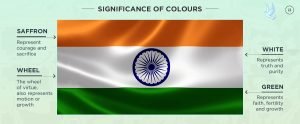On July 22’ 2022, Prime Minister Narendra Modi, launched the campaign “HAR GHAR TIRANGA” to mark the 75thIndependence Day and urged people to change the display pictures of their social media accounts to the Tricolour. The campaign will mark the 75th Independence Day as Azadi ka Amrit Mahotsav.
Under the campaign, the Tricolour is expected to be hoisted atop more than 20 Crore homes across the country on Independence Day eve. PM Modi, who himself put the Tricolour as his Twitter profile photo on Tuesday.
The purpose of this concept behind this campaign is to awaken the spirit of patriotism in the hearts of the citizens and to celebrate the 75th Independence Day of the country with the spirit of public participation. When we participate in such campaigns, we need to keep in mind to follow the set of rules related to the national flags. The Flag Code of India 2002’ and the Prevention of Insults to National Honour Act, 1971guide us and provide us the path to use, display and hoisting of the National Flag.

On 26th January 2002, the Flag Code of India took effect and it brings together all laws, conventions, practices, and instructions for the display of the National Flag. As per paragraph 1.3 & 1.4 of the Flag Code of India, the National Flag shall be rectangular in shape. The Flag can be of any size but the ratio of the length to the height (width) of the National Flag shall be 3:2. It should occupy the position of honor and should be distinctly placed. A damaged or dishevelled National Flag should not be displayed.
Also Read :- Har Ghar Tiranga Registration And Certificate Download Link 2022
History of our Tiranga
1921 A student, Pingali (or Pinglay) Venkayya presents a flag design for All-India Congress to Gandhiji with red and green as primary colours.
Gandhiji adds colours to the flag Gandhiji adds white in centre and, as suggested by Lala H.R Sondhi, adds the Indian charkha linked with his crusade to make Indians self-reliant.
May 1923, Nagpur Hundreds arrested for carrying the flag during peaceful protests against British rule.
August 31, 1931 The Congress flag officially recognized as the national flag. At the same time, the current arrangement of stripes and the use of deep saffron instead of red were approved.
World War Il in 1943, Bose goes with the “Azad Hind Fauj and hoists a variant of the flag for the first time in Port Blair, Andamans.
July 22, 1947 A historic moment as the Indian National Flag gets adopted It retained the saffron-white-green stripes, but with the Dharma Chakra, in place of the spinning wheel.











